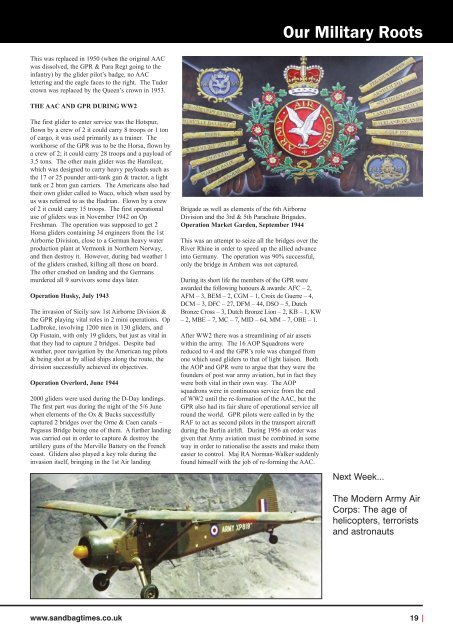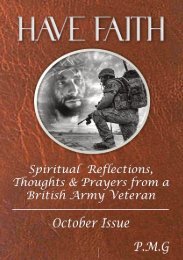You also want an ePaper? Increase the reach of your titles
YUMPU automatically turns print PDFs into web optimized ePapers that Google loves.
Our Military Roots<br />
This was replaced in 1950 (when the original AAC<br />
was dissolved, the GPR & Para Regt going to the<br />
infantry) by the glider pilot’s badge, no AAC<br />
lettering and the eagle faces to the right. <strong>The</strong> Tudor<br />
crown was replaced by the Queen’s crown in 1953.<br />
THE AAC AND GPR DURING WW2<br />
<strong>The</strong> first glider to enter service was the Hotspur,<br />
flown by a crew of 2 it could carry 8 troops or 1 ton<br />
of cargo, it was used primarily as a trainer. <strong>The</strong><br />
workhorse of the GPR was to be the Horsa, flown by<br />
a crew of 2; it could carry 28 troops and a payload of<br />
3.5 tons. <strong>The</strong> other main glider was the Hamilcar,<br />
which was designed to carry heavy payloads such as<br />
the 17 or 25 pounder anti-tank gun & tractor, a light<br />
tank or 2 bren gun carriers. <strong>The</strong> Americans also had<br />
their own glider called to Waco, which when used by<br />
us was referred to as the Hadrian. Flown by a crew<br />
of 2 it could carry 15 troops. <strong>The</strong> first operational<br />
use of gliders was in <strong>No</strong>vember 1942 on Op<br />
Freshman. <strong>The</strong> operation was supposed to get 2<br />
Horsa gliders containing 34 engineers from the 1st<br />
Airborne Division, close to a German heavy water<br />
production plant at Vermonk in <strong>No</strong>rthern <strong>No</strong>rway,<br />
and then destroy it. However, during bad weather 1<br />
of the gliders crashed, killing all those on board.<br />
<strong>The</strong> other crashed on landing and the Germans<br />
murdered all 9 survivors some days later.<br />
Operation Husky, July 1943<br />
<strong>The</strong> invasion of Sicily saw 1st Airborne Division &<br />
the GPR playing vital roles in 2 mini operations. Op<br />
Ladbroke, involving 1200 men in 130 gliders, and<br />
Op Fustain, with only 19 gliders, but just as vital in<br />
that they had to capture 2 bridges. Despite bad<br />
weather, poor navigation by the American tug pilots<br />
& being shot at by allied ships along the route, the<br />
division successfully achieved its objectives.<br />
Operation Overlord, June 1944<br />
2000 gliders were used during the D-Day landings.<br />
<strong>The</strong> first part was during the night of the 5/6 June<br />
when elements of the Ox & Bucks successfully<br />
captured 2 bridges over the Orne & Caen canals –<br />
Pegasus Bridge being one of them. A further landing<br />
was carried out in order to capture & destroy the<br />
artillery guns of the Merville Battery on the French<br />
coast. Gliders also played a key role during the<br />
invasion itself, bringing in the 1st Air landing<br />
Brigade as well as elements of the 6th Airborne<br />
Division and the 3rd & 5th Parachute Brigades.<br />
Operation Market Garden, September 1944<br />
This was an attempt to seize all the bridges over the<br />
River Rhine in order to speed up the allied advance<br />
into Germany. <strong>The</strong> operation was 90% successful,<br />
only the bridge in Arnhem was not captured.<br />
During its short life the members of the GPR were<br />
awarded the following honours & awards: AFC – 2,<br />
AFM – 3, BEM – 2, CGM – 1, Croix de Guerre – 4,<br />
DCM – 3, DFC – 27, DFM – 44, DSO – 5, Dutch<br />
Bronze Cross – 3, Dutch Bronze Lion – 2, KB – 1, KW<br />
– 2, MBE – 7, MC – 7, MID – 64, MM – 7, OBE – 1.<br />
After WW2 there was a streamlining of air assets<br />
within the army. <strong>The</strong> 16 AOP Squadrons were<br />
reduced to 4 and the GPR’s role was changed from<br />
one which used gliders to that of light liaison. Both<br />
the AOP and GPR were to argue that they were the<br />
founders of post war army aviation, but in fact they<br />
were both vital in their own way. <strong>The</strong> AOP<br />
squadrons were in continuous service from the end<br />
of WW2 until the re-formation of the AAC, but the<br />
GPR also had its fair share of operational service all<br />
round the world. GPR pilots were called in by the<br />
RAF to act as second pilots in the transport aircraft<br />
during the Berlin airlift. During 1956 an order was<br />
given that Army aviation must be combined in some<br />
way in order to rationalise the assets and make them<br />
easier to control. Maj RA <strong>No</strong>rman-Walker suddenly<br />
found himself with the job of re-forming the AAC.<br />
Next Week...<br />
<strong>The</strong> Modern Army Air<br />
Corps: <strong>The</strong> age of<br />
helicopters, terrorists<br />
and astronauts<br />
www.sandbagtimes.co.uk 19 |


















